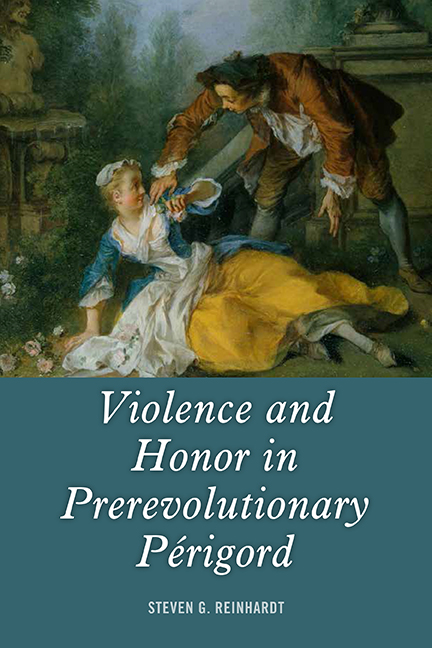Book contents
- Frontmatter
- Dedication
- Contents
- Acknowledgments
- Maps
- Introduction: “The Saint of Honor”
- 1 Violence and Honor
- 2 Honor in a Cross-Cultural Context
- 3 From Honor to Honnêteté in Old Regime Europe
- 4 “The Good Old Days” in Prerevolutionary Sarladais
- 5 “The Saint of Honor” in the Sénéchaussée of Sarlat
- 6 Women and Honor-Related Criminal Affaires
- 7 Policing Honnêteté: Shameful, Sinful, and Criminal Conduct
- 8 “Fallen Women” and Infanticide
- 9 Compromised Honor and Dangerous Liaisons
- 10 Honor and Homicide
- Conclusion
- Notes
- Bibliography
- Index
8 - “Fallen Women” and Infanticide
Published online by Cambridge University Press: 10 June 2021
- Frontmatter
- Dedication
- Contents
- Acknowledgments
- Maps
- Introduction: “The Saint of Honor”
- 1 Violence and Honor
- 2 Honor in a Cross-Cultural Context
- 3 From Honor to Honnêteté in Old Regime Europe
- 4 “The Good Old Days” in Prerevolutionary Sarladais
- 5 “The Saint of Honor” in the Sénéchaussée of Sarlat
- 6 Women and Honor-Related Criminal Affaires
- 7 Policing Honnêteté: Shameful, Sinful, and Criminal Conduct
- 8 “Fallen Women” and Infanticide
- 9 Compromised Honor and Dangerous Liaisons
- 10 Honor and Homicide
- Conclusion
- Notes
- Bibliography
- Index
Summary
In traditional societies, the demands of the honor code weigh especially heavily on women, whose primary (but not only) honor-related duty is the maintenance of sexual modesty. In the eighteenth-century Sarladais, sexual honor was an all-or-nothing virtue; once lost, it could never be recovered. Therefore, if a woman failed to uphold the most deeply held values of her family and community, she could expect to suffer the consequences.
Although the judicial records contain no mention of “honor killings” per se in the eighteenth-century Sarladais, a young woman who violated the code by conceiving out of wedlock had to be prepared to experience less extreme but very real sanctions. Honor remained a collective obsession. Young women who served as domestic or agricultural servants were particularly vulnerable and risked losing what honor they could claim when they were cajoled, pressured, intimidated by threats, or actually coerced into extramarital sexual relations. Others may have entered voluntarily into consensual sexual relations after receiving assurances of marriage, whether sincerely given or falsely proffered. Still others may have made the calculated gamble that an alleged or actual pregnancy would convince a reluctant lover to act honorably. At times, the stumbling block that ruled out the possibility of marriage was the disparity of social status between the man and woman. If he was of higher social status (as was often the case) or already engaged or even wed, marriage was out of the question. In that case, a woman's only real options were abortion, abandonment, or infanticide.
Bourgeois and noble families were especially wary of social-climbing young peasant women who might ensnare their sons; therefore, sons were forewarned about possible entrapment. In cases where a son did not heed parental warnings and was willing or even eager to marry beneath himself, the family might intervene because it intended its son (especially if he were heir to the family fortune) to make a better match than one with a lowstatus girl of little fortune. One way of settling the affair and avoiding the publicity of legal proceedings was for his parents to convince some other young man, someone more “suitable,” to marry the expectant mother and accept the child as his own—often in exchange for appropriate compensation.
- Type
- Chapter
- Information
- Violence and Honor in Prerevolutionary Périgord , pp. 170 - 194Publisher: Boydell & BrewerPrint publication year: 2018

